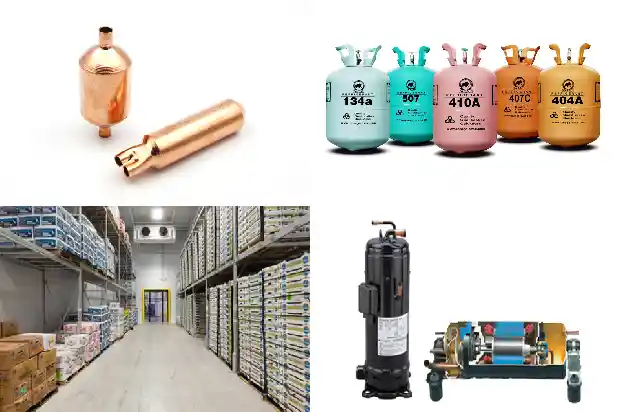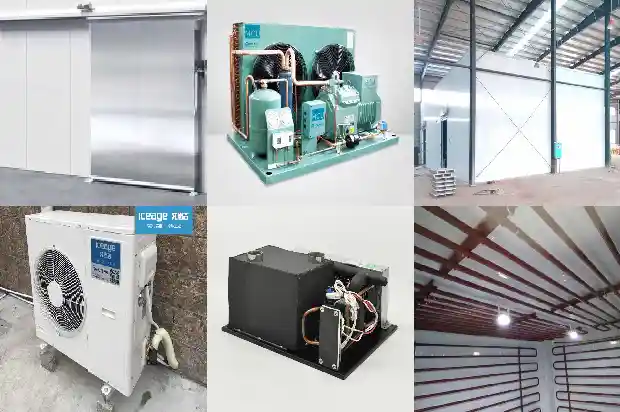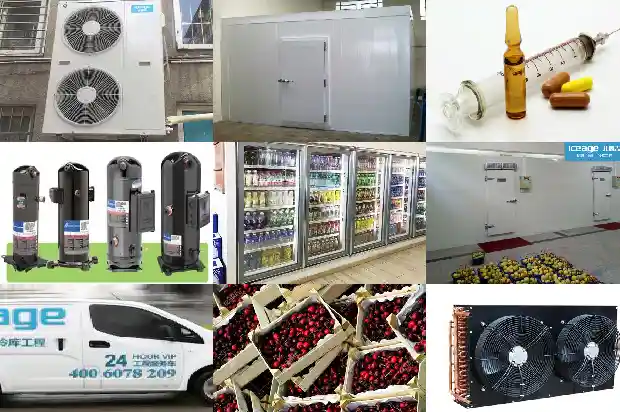The Significance of Subcooling Degree in Refrigeration Systems and Methods for Achieving Subcooling
2024-11-17
I. Definition of Subcooling
- Definition of Degree of Subcooling: The difference between the saturated liquid temperature corresponding to the condensing pressure in the condenser and the actual temperature of the liquid at the outlet of the condenser.
- Representation of Degree of Subcooling on the Pressure-Enthalpy Diagram:
In engineering, generally, the discharge pressure is approximately regarded as the condensing pressure. The difference between the saturated liquid temperature corresponding to the discharge pressure and the temperature of the liquid at the outlet of the condenser is taken as the degree of subcooling. The reason for such an approximation is that the pressure drop in the condenser is relatively small compared to that in the evaporator. The difference between the discharge pressure and the actual condensing pressure is small, and the error caused by this approximation can be neglected.
II. Why the Refrigeration System Must Have a Degree of Subcooling
Simply put, if there is no degree of subcooling in the refrigeration system, the refrigerant will "flash" in the liquid pipe, and the refrigeration effect will be reduced.
For air-cooled condensers, a degree of subcooling of 3 - 5 °C is more appropriate.
During the normal circulation of the refrigeration system, there will generally be a certain degree of subcooling at the outlet of the condenser.
If there is no degree of subcooling, when the pressure of the liquid in the two-phase refrigerant in the "liquid pipe" has a slight loss, the liquid will "flash". As the saturated liquid is bound to evaporate due to the decrease in pressure. When the liquid evaporates, it will absorb the surrounding heat, and the remaining liquid will then cool down and reach the saturated temperature under the corresponding pressure. In this way, the two-phase refrigerant will flash, become saturated while moving forward until it reaches the inlet of the evaporator. Eventually, the dryness of the two-phase refrigerant reaching the evaporator will be much larger than the designed dryness, the liquid phase component will decrease, and it will not be able to meet the evaporation amount of the evaporator, and of course, the refrigeration effect will be reduced.
In addition, only with a certain degree of subcooling can a reliable pressure-enthalpy diagram be drawn. For a basic single-stage compression refrigeration system, there are four points on the pressure-enthalpy diagram, which are:
① The suction port of the compressor - superheated vapor;
② The discharge port of the compressor - superheated vapor;
③ The outlet of the condenser - subcooled liquid;
④ The inlet of the evaporator - two-phase refrigerant.
Points ①, ② and ③ are all in single-phase states.
According to the pressure and enthalpy values, the positions can be determined in the pressure-enthalpy diagram.
The inlet of the evaporator is two-phase refrigerant. Even if the pressure and temperature values are known, it is difficult to calculate the enthalpy value.
However, the throttling device generally has a small external surface area, and the heat dissipation can be neglected. The refrigerant passing through the throttling device can be approximately regarded as an isenthalpic pressure reduction process. So the enthalpy value at point ③ can be approximately equal to the enthalpy value at the outlet of the condenser.
If the outlet of the condenser is two-phase or saturated liquid, it is difficult to obtain the enthalpy value.
For air-cooled condensers, a degree of subcooling of 3 - 5 °C is more appropriate.
During the normal circulation of the refrigeration system, there will generally be a certain degree of subcooling at the outlet of the condenser.
If there is no degree of subcooling, when the pressure of the liquid in the two-phase refrigerant in the "liquid pipe" has a slight loss, the liquid will "flash". As the saturated liquid is bound to evaporate due to the decrease in pressure. When the liquid evaporates, it will absorb the surrounding heat, and the remaining liquid will then cool down and reach the saturated temperature under the corresponding pressure. In this way, the two-phase refrigerant will flash, become saturated while moving forward until it reaches the inlet of the evaporator. Eventually, the dryness of the two-phase refrigerant reaching the evaporator will be much larger than the designed dryness, the liquid phase component will decrease, and it will not be able to meet the evaporation amount of the evaporator, and of course, the refrigeration effect will be reduced.

In addition, only with a certain degree of subcooling can a reliable pressure-enthalpy diagram be drawn. For a basic single-stage compression refrigeration system, there are four points on the pressure-enthalpy diagram, which are:
① The suction port of the compressor - superheated vapor;
② The discharge port of the compressor - superheated vapor;
③ The outlet of the condenser - subcooled liquid;
④ The inlet of the evaporator - two-phase refrigerant.
Points ①, ② and ③ are all in single-phase states.

According to the pressure and enthalpy values, the positions can be determined in the pressure-enthalpy diagram.
The inlet of the evaporator is two-phase refrigerant. Even if the pressure and temperature values are known, it is difficult to calculate the enthalpy value.
However, the throttling device generally has a small external surface area, and the heat dissipation can be neglected. The refrigerant passing through the throttling device can be approximately regarded as an isenthalpic pressure reduction process. So the enthalpy value at point ③ can be approximately equal to the enthalpy value at the outlet of the condenser.
If the outlet of the condenser is two-phase or saturated liquid, it is difficult to obtain the enthalpy value.

III. Significance of the Degree of Subcooling in the Refrigeration System
Why can't the corresponding enthalpy value be calculated according to the pressure and temperature in the two-phase state?
Because in the two-phase region, the pressure and the temperature are in one-to-one correspondence. One saturated pressure corresponds to one saturated temperature. The pressure line and the temperature line are a coincident horizontal line in the two-phase region.
Due to measurement errors, it is very difficult to make the measured pressure values and temperature values correspond one by one:
① If the temperature value is less than the saturated temperature corresponding to the pressure, it indicates that it is a subcooled liquid;
② If the temperature value is greater than the saturated temperature corresponding to the pressure, it indicates that it is a superheated gas.
This contradicts the previous condition that the refrigerant is in a two-phase state.
Can it be said that the refrigerant is on the saturated liquid or saturated line of the measured pressure value, and the enthalpy value is replaced by the enthalpy value of its saturated liquid or saturated gas?
This is also not possible, because when the saturated temperature differs by 0.1 degree up or down, its corresponding enthalpy value will vary by 100 - 200 kJ/kg.
It is difficult to determine the actual position of the two-phase point on the pressure-enthalpy diagram, whether it is on the saturated liquid line, the saturated gas line, or at a certain position on the horizontal line between them.
Therefore, there must be sufficient subcooling or superheating to calculate the corresponding enthalpy value.
Because in the two-phase region, the pressure and the temperature are in one-to-one correspondence. One saturated pressure corresponds to one saturated temperature. The pressure line and the temperature line are a coincident horizontal line in the two-phase region.
Due to measurement errors, it is very difficult to make the measured pressure values and temperature values correspond one by one:
① If the temperature value is less than the saturated temperature corresponding to the pressure, it indicates that it is a subcooled liquid;
② If the temperature value is greater than the saturated temperature corresponding to the pressure, it indicates that it is a superheated gas.
This contradicts the previous condition that the refrigerant is in a two-phase state.
Can it be said that the refrigerant is on the saturated liquid or saturated line of the measured pressure value, and the enthalpy value is replaced by the enthalpy value of its saturated liquid or saturated gas?
This is also not possible, because when the saturated temperature differs by 0.1 degree up or down, its corresponding enthalpy value will vary by 100 - 200 kJ/kg.
It is difficult to determine the actual position of the two-phase point on the pressure-enthalpy diagram, whether it is on the saturated liquid line, the saturated gas line, or at a certain position on the horizontal line between them.
Therefore, there must be sufficient subcooling or superheating to calculate the corresponding enthalpy value.
IV. Methods for Achieving Subcooling
- Install a subcooler after the condenser;
- Appropriately increase the area of the condenser during design and selection;
- Set a regenerator in the refrigeration system and adopt a regenerative cycle.
Related Articles
- What are the important significances of a warm environment for various types of food?
- Cold and Hyperinflation: Significance and Applications
- Have You Encountered the Three Common Problems of Refrigeration Compressors?
- How to Calculate Refrigeration Load? And What Are the Issues?
- What to Do if the Compressor of a Frozen and Refrigerated Display Cabinet Runs but the Refrigeration Effect Is Poor?
- Instructions for Welding and Drainage in the Installation of Refrigeration Equipment Pipelines
- Common Pressure Valves and Protection Devices in Refrigeration Units
- Precautions for Using Rotary Refrigeration Compressors
- What Misconceptions Should Be Avoided in Low - temperature Refrigeration System Repairs
- Essential for Maintenance! Parameters and Phenomena of Normal Operation of Refrigeration and Heating Systems
- Composition and Common Faults of Screw Refrigeration Compressors
- How to Read the High - and Low - Pressure Gauges of Refrigeration Air - conditioners?
- What is Cascade Refrigeration?
- Introduction to Control Valves in Refrigeration Systems
- Welding Equipment Used in Refrigeration System Maintenance
- Where Lie the Key Construction Technologies of the Ammonia Refrigeration System?
- What to Do When a Refrigeration Unit Malfunctions?
- Could a Tiny Copper Tube Cause a Multi - split Air Conditioner to Stop Cooling? Refrigeration Workers Must Pay Attention!
